프랑스 연구진이 지난 7월 16일까지 28개국 신종플루 사망자 574명을 분석한 결과입니다.
2009년 7월 16일 기준으로 보고된 사례 당 사망자수(치명율)은 0.6%이며, 사망자가 발생한 국가별 치명율은 0.1%~ 5.1%였습니다.
성별 사망자 수는 남성 257명, 여성 246명으로 거의 비슷했는데, 남성이 약간 높았습니다.
20~49세 젊은 층에서 사망자의 51%가 발생했으며, 60세 이상 사망자는 12%로 상대적으로 비율이 적은 것으로 확인되었습니다.
사망자의 50% 이상은 다른 질병에 걸린 상태였으며, 임산부, 대사성 질환자, 비만한 사람 등이 돼지독감 바이러스에 더 취약한 것으로 드러났습니다.
이번 연구는 백신 우선접종 대상자를 선정하는데 참고자료로 사용될 수 있는 유용한 자료라는 생각입니다.
Eurosurveillance, Volume 14, Issue 33, 20 August 2009
Epidemiology of fatal cases associated with pandemic H1N1 influenza 2009
- French Institute for Public Health Surveillance (Institut de Veille Sanitaire, InVS), St Maurice, France
- The members of the epidemic intelligence team at InVS are listed at the end of the article
Date of submission: 07 August 2009
This article describes the characteristics of 574 deaths associated with pandemic H1N1 influenza up to 16 July 2009. Data (except from Canada and Australia) suggest that the elderly may to some extent be protected from infection. There was underlying disease in at least half of the fatal cases. Two risk factors seem of particular importance: pregnancy and metabolic condition (including obesity which has not been considered as risk factor in previous pandemics or seasonal influenza).
To date, there are few data on risk factors, severe cases and deaths associated with pandemic H1N1 influenza 2009. Estimating and interpreting case fatality ratios (CFR) is difficult, mainly due to the challenge of accurately estimating the numerator (N deaths) and the denominator (N cases) [1], especially during a pandemic that is still evolving. Furthermore, many countries have abandoned individual case counts and systematic screening of all suspect cases. This article aims to describe the characteristics of reported deaths, to assess the CFR and high-risk profiles linked with underlying disease, while assessing possible bias.
Methods
The study is based on an analysis of available data until 16 July 2009, as compiled by the epidemic intelligence team at the French institute for public health surveillance (Institut de Veille Sanitaire, InVS), using a well-defined methodology [2]. The individual or aggregated data originated from validated official sources (Ministries of Health, local or national public health authorities, European Centre for Disease Prevention and Control, United States Centers for Disease Control and Prevention, World Health Organization), completed by informal sources when needed.
Results
The first (retrospectively) confirmed death occurred in Oaxaca State, Mexico, (onset of symptoms on 4 April 2009). As of 16 July 2009, InVS was aware of 684 confirmed deaths reported worldwide since the start of the pandemic (Figure 1) for a total of 126,168 reported cases (Figure 2). At this stage, no deaths had been reported and scarce data was available from African countries.
Figure 1. Deaths associated with pandemic H1N1 influenza 2009 reported officially worldwide as of 16 July 2009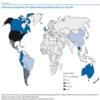
Figure 2. Breakdown of fatal case counts used in our analysis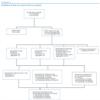
Data were available for 574 deaths associated with pandemic H1N1 influenza 2009: individual data for 449 cases in 26 countries (Table 1, Figure 2) and aggregated data for 125 cases in Mexico [3].
Table 1. Available individual and aggregated data on cases of pandemic H1N1 influenza 2009 and associated deaths worldwide, by country, as of 16 July 2009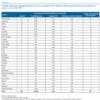
The quality and completeness of the data regarding age, sex, date of death and the notion of underlying disease varied greatly for each case. The overall ‘computed CFR’ (number of reported deaths per number of reported cases as of 16 July 2009) was 0.6% and varied from 0.1% to 5.1% depending on the country (and the accurate quantification of deaths and overall case counts) (Table 1).
Deaths by sex and age
Data on sex were available for 503 fatal cases worldwide (257 men and 246 women, sex ratio=1.04). Data on age were available for 468 fatal cases worldwide (343 with individual data and 125 with aggregated data). Data on both information (age and sex) were available for 448 fatal cases (Figure 3).
Figure 3. Deaths associated with pandemic H1N1 influenza worldwide by age and sex, as of 16 July 2009* (n=448)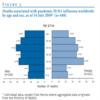
Although previous reports suggested that cases of pandemic H1N1 influenza 2009 occurred mainly in children [4], the mean and median age of the 343 fatal cases in our analysis were 37 years (range 0-85 years). Most deaths (51%) occurred in the age group of 20-49 year-olds, but there was considerable variation depending on country or continent (Table 2). Overall, 12% of deaths occurred in cases aged 60 years or more, but 36% of reported deaths in Canada (mainly female) and 28% in Australia occurred in this age group.
Table 2. Deaths associated with pandemic H1N1 influenza 2009*, percentage and mortality rate (per million inhabitants), by age group and by country or continent**, as of 16 July 2009 (n=468)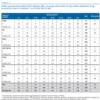
Underlying risks
Pregnancy
As of 16 July 2009, 16 women (10% of all individually documented female cases who died and 30% of the 20-39 year-old women who died) were pregnant or had delivered at the time of their death. Among these 16 women, at least eight had documented underlying health risks (obesity, heart disease or a respiratory disease such as asthma or tuberculosis). No information was available as to the underlying health status of the eight remaining women who died.
Underlying disease
A sub-analysis examined the 354 cases (241 cases with individual data and 113 with aggregated data) who died and were also documented for underlying disease and for sex and/or age (Figure 2). Presence or absence of underlying disease was documented for 241 of 449 (53% of the 449 cases with individual data) of deaths with individual data. Of these, 218 (90%) had documented underlying disease and 23 (10%) had documented absence of underlying disease. A further sub-analysis was conducted on 102 cases of known sex (80 with detailed underlying disease and 22 without disease) and 93 cases of known age (75 with detailed underlying disease and 18 without disease) (Figure 2). Underlying disease (or its absence) was equally distributed between the sexes, but understandably not among age groups (Figure 4). A high proportion of young children (27% of the 0-9 year-olds) and young adults (22% of the 20-29 year-olds) had no documented underlying disease, while 60% of people over the age of 60 years had heart or respiratory disease. Diabetes and obesity were the most frequently identified underlying conditions (Figure 5) and were found in fatal cases over the age of 20 years (the World Health organization defines “obesity” as a body mass index equal to or more than 30, but as the reporting format differed between sources and no standard definition of childhood obesity is applied worldwide, we cannot be sure the same definition has been applied for all cases). In the 13 fatal cases with individual detailed data on metabolic conditions, seven cases had obesity, five cases had diabetes, and one case had both. The available data for the other cases did not specificy whether the metabolic condition included obesity only, diabetes only, or both.
Figure 4. Distribution of underlying diseases in pandemic H1N1 influenza 2009-associated deaths by age, worldwide* as of 16 July 2009 (116 disorders documented in 93 fatal cases)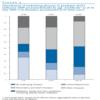
Figure 5. Underlying diseases in pandemic H1N1 influenza 2009-associated deaths worldwide* as of 16 July 2009 (213 diseases documented in 193 fatal cases)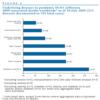
Discussion and conclusions
Most cases described during the three pandemics of the 20th century and during seasonal influenza involve transient illness not requiring hospitalisation. Most deaths are described in the very young or the elderly or those with underlying disease. The 1918-1919 pandemic, however, was characterised by a high mortality rate in healthy young adults and an estimated CFR of 2-3% [5]. Even with a low CFR, seasonal influenza epidemics cause significant morbidity and mortality with an estimated three to five million cases of severe illness and about 250,000 to 500,000 deaths worldwide [6].
To date, the CFR attributable to the current H1N1 pandemic has been estimated at around 0.4%, based on surveillance data from Mexico and mathematical modelling [7]. This CFR is higher than that of average seasonal influenza but remains of the same order of magnitude. Whether this will change before the expected epidemic peak in the northern hemisphere in the autumn is unknown.
Evaluating CFR during a pandemic is a hazardous exercise. Aside from the issue of whether or not a death has been caused by the influenza infection, cases tend to be detected initially among severely ill patients with a higher probability of dying. This leads to an overestimation of the computed CFR at the beginning of an outbreak. The computed CFR subsequently evolves as the case reporting strategy is adapted to the situation. When the situation no longer requires exhaustive reporting of cases, the computed CFR will inevitably increase and grossly overestimate the true CFR.
Specific investigations or modelling allow for a more accurate estimation of the number of cases. As of 27 May 2009, there had been 820 confirmed cases in New York City, of whom two had died, resulting in a computed CFR of 0.2%. A telephone survey estimated that in fact 250,000 cases had occurred in that city of 8.3 million inhabitants, resulting in an estimated CFR of 0.0008% [8,9]. In the United Kingdom (UK), there were 28 deaths reported for a documented 10,649 cases as of 16 July 2009 and a computed CFR of 0.26%. However, health authorities estimated that the cumulative number in the UK on that date was 65,649 cases and 28 deaths, which corresponds to an estimated CFR of 0.04% [10].
The pandemic, however, is far from over, and deaths will unfortunately continue to occur. As in previous pandemics, available data show that age groups are not equally affected. Compared to younger age groups, the elderly seem to be protected from infection to some extent, perhaps due to previous exposure to strains akin to influenza A(H1N1)v virus [11-13]. When infection does occur, however, the percentage of deaths in elderly cases seems to be higher than in others. Initial estimates available from Mexico for the period until 16 July 2009 showed that the risk of death in aged cases (over 50 years) was higher (6% deaths among cases) than in children (0-1% deaths among cases aged 0-19 years) and young adults (2-4% deaths among cases aged 20-49 years) [3].
There was documented underlying disease in at least 49% of documented fatal cases worldwide to date. Diseases most frequently associated with death were the same as those identified for death from seasonal influenza. Nevertheless, two risk factors are noticeable: pregnancy and obesity. Pregnancy is a well-documented risk factor for severe infection and death in seasonal influenza and in previous pandemics [14-16]. The role of obesity, however, remains to be further analysed in order to ascertain whether the risk is linked with complications of obesity during intensive care [17,18] or with a severe course of disease due to diabetes frequently associated with obesity [19], or whether obesity plays a specific role in the pathogenesis of severe influenza A(H1N1)v infection, for example by interfering with the host’s immune responses, as has been shown in rodents [20].
All the data presented here were from official sources and were carefully documented. Yet they are to be interpreted cautiously due to the variable quality of data regarding underlying disease (especially for pre-existing respiratory disease), small numbers, incomplete reporting using different formats, a mixture of individual and aggregated data, epidemic dynamics within the population (epidemics initially affecting school children or travellers) and population structure. For instance, we found that deaths in Canada seem to have been especially frequent in elderly women. Finally, the difficulty in determining whether the cause of death is attributable to influenza A(H1N1)v infection or to associated factors remains a major limitation.
The proportion of deaths with documented underlying disease must be interpreted with care due to a significant amount of missing data. There may be an information bias which overestimates the proportion of underlying disease since its presence may be reported more readily than its absence.
The analysis in this article is based on data collected only 10 weeks after the first international alert, and the pandemic is still in its very early phase. All evidence acquired so far remains to be completed and confirmed in the coming months, especially in view of the influenza epidemics currently ongoing in the southern hemisphere. Surveillance of the progression of the pandemic H1N1 influenza 2009 will focus more and more on severe cases. A more reliable CFR could be estimated through specific surveys, mathematical modelling, syndromic surveillance of influenza-like illness and of reported deaths in the population. Encouraging reporting in a common international format would also be useful.
The epidemic intelligence team at InVS includes (in alphabetical order):
F Aït el-Belghiti, P Barboza, C Baudon, L Cherie-Challine, S Cohuet, M-A Degail, D Dejour-Salamanca, M Gastellu-Etchegorry, V Gauthier, J Gueguen, G La Ruche, A Rachas, A Tarantola, L Vaillant.
- Garske T, Legrand J, Donnelly CA, Ward H, Cauchemez S, Fraser C, et al. Assessing the severity of the novel influenza A/H1N1 pandemic. BMJ 2009;339:b2840.
- Institut de Veille Sanitaire (InVS). Departement International et Tropical. Veille internationale à l’InVS. [International Surveillance at InVS]. 22 April 2008. French. Available from: http://www.invs.sante.fr/international/notes/note_veille_internationale.pdf.
- Mexican Secretariat of Health [Secretaría de Salud de México]. Situación actual de la epidemia. [Current situation of the epidemic]. 16 July 2009. Spanish. Available from: http://portal.salud.gob.mx/descargas/pdf/influenza/situacion_actual_epidemia_160709.pdf. 2009.
- World Health Organization. New influenza A (H1N1) virus: global epidemiological situation, June 2009. Wkly Epidemiol Rec. 2009; 84(25):249-57.
- The European Scientific Working Group on influenza (ESWI). Pandemics of the 20th Century. 2009. Available from: http://www.flucentre.org/files/Pandemics%20of%20the%2020th%20century.pdf.
- World Health Organization. Influenza (seasonal) factsheet. April 2009. Available from: http://www.who.int/mediacentre/factsheets/fs211/en/
- Fraser C, Donnelly CA, Cauchemez S, Hanage WP, Van Kerkhove MD, Hollingsworth TD, et al. Pandemic potential of a strain of influenza A (H1N1): Early findings. Science. 2009;324(5934):1557-61.
- New York City Department of Health and Mental Hygiene. Prevalence of Flu-like Illness in New York City: May 2009. 2009. http://www.nyc.gov/html/doh/downloads/pdf/cd/h1n1_citywide_survey.pdf.
- Weisfuse IB. The H1N1 Outbreak in New York City. 2009. Available from: http://www.se2009.eu/polopoly_fs/1.7824!menu/standard/file/PowerPoint%20Isaac%20Weisfuse%20J%C3%B6nk%C3%B6ping%202009.ppt.
- Health Protection Agency. Weekly pandemic flu update. 16 July 2009. Available from: http://www.hpa.org.uk/webw/HPAweb&HPAwebStandard/HPAweb_C/1247728933406?p=1231252394302.
- Itoh Y, Shinya K, Kiso M, Watanabe T, Sakoda Y, Hatta M, et al. In vitro and in vivo characterization of new swine-origin H1N1 influenza viruses. Nature. 2009 Jul 13. [Epub ahead of print].
- Centers for Disease Control and Prevention (CDC). Serum cross-reactive antibody response to a novel influenza A (H1N1) virus after vaccination with seasonal influenza vaccine. MMWR Morb Mortal Wkly Rep. 2009;58(19):521-4.
- Chowell G, Bertozzi SM, Colchero MA, Lopez-Gatell H, Alpuche-Aranda C, Hernandez M, et al. Severe respiratory disease concurrent with the circulation of H1N1 influenza. N Engl J Med. 2009;361(7):674-9.
- Rasmussen SA, Jamieson DJ, Macfarlane K, Cragan JD, Williams J, Henderson Z. Pandemic Influenza and Pregnant Women: Summary of a Meeting of Experts. Am J Public Health. 2009 Jun 18. [Epub ahead of print].
- Jamieson DJ, Honein MA, Rasmussen SA, Williams JL, Swerdlow DL, Biggerstaff MS, et al. H1N1 2009 influenza virus infection during pregnancy in the USA. Lancet. 2009;374(9688):451-8.
- Mullooly JP, Barker WH, Nolan TF Jr. Risk of acute respiratory disease among pregnant women during influenza A epidemics. Public Health Rep. 1986;101(2):205-11.
- Centers for Disease Control and Prevention (CDC). Intensive-care patients with severe novel influenza A (H1N1) virus infection – Michigan, June 2009. MMWR Morb Mortal Wkly Rep. 2009;58(27):749-52.
- Malhotra A, Hillman D. Obesity and the lung: 3. Obesity, respiration and intensive care. Thorax. 2008;63(10):925-31.
- Wong CM, Yang L, Chan KP, Leung GM, Chan KH, Guan Y, et al. Influenza-associated hospitalization in a subtropical city. PLoS Med. 2006;3(4):e121.
- Smith AG, Sheridan PA, Harp JB, Beck MA. Diet-induced obese mice have increased mortality and altered immune responses when infected with influenza virus. J Nutr. 2007;137(5):1236-43.
=====================================
2009년 8월 21일자 WHO 공식집계 상 감염자 182166명, 사망자 1799명
(치사율 0.99%, 전세계 인구 68억명 중 0.0027% 감염)
<지역별 치사율>
아프리카 0.2%
아메리카 1.5%
중동 0.3%
유럽 0.17%
남아시아 및 동아시아 0.8%
서태평양 0.18%
실제 감염율은 WHO 통계보다 훨씬 높을 것으로 추정되며, 실제 치사율은 WHO 통계보다 훨씬 낮을 것으로 추정된다. 왜냐하면 WHO는 각국 보건당국에게 더 이상 SI 검사나 개별 사례에 대한 보고를 하지 말라고 했기 때문이다. 그러므로 사망자 통계는 집계가 되지만 감염자 통계는 현실을 반영하고 있다고 볼 수 없다.
Pandemic (H1N1) 2009 – update 62 (revised 21 August 2009)
Laboratory-confirmed cases of pandemic (H1N1) 2009 as officially reported to WHO by States Parties to the IHR (2005) as of 13 August 2009
출처 : WHO (http://www.who.int/csr/don/2009_08_21/en/index.html)
The countries and overseas territories/communities that have newly reported their first pandemic (H1N1) 2009 confirmed case(s) since the last web update (No. 61) as of 13 August 2009 are:
Ghana, Zambia, and Tuvalu
Map of affected countries and deaths as of 13 August 2009 [png 313kb]
Region Cumulative total as of 13 Aug 2009 Cases* Deaths WHO Regional Office for 1469 3 WHO Regional Office for the 105882 1579 WHO Regional Office for the 2532 8 WHO Regional Office for Over 32000 53 WHO Regional Office for 13172 106 WHO Regional Office for the Western Pacific (WPRO) 27111 50 Total Over 182166 1799
*Given that countries are no longer required to test and report individual cases, the number of cases reported actually understates the real number of cases.